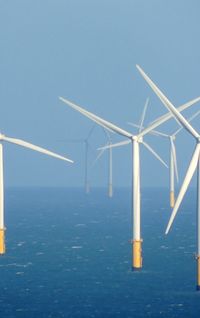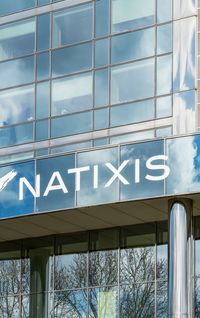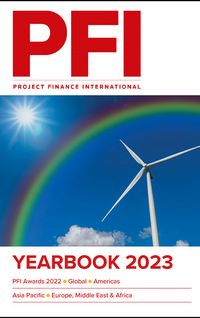The NeuConnect interconnector is a landmark new energy project for Europe, creating the first direct link between the UK and Germany, and helping to connect two of Europe’s largest energy markets for the first time. By Sergio Rodriguez Casado, partner, and Olivier Bramaud-Grattau, partner, Meridiam; Arnaud Grévoz, CEO, NeuConnect; Yann Le Bot, director, Energy+, and Nicolas Pothier, vice-president, Energy+, Societe Generale.
Developed by lead investor Meridiam (51%), with Allianz Capital Partners (25%), Kansai Electric Power (17.5%) and TEPCO (6.5%), NeuConnect will become one of the world’s largest interconnectors at 725km in length and the £2.4bn/€2.8bn scheme is currently the single largest Anglo-German investment project.
The new link will allow 1.4GW of electricity to flow in either direction between the UK and Germany, helping to boost security of energy supply in each country at a time when energy resilience is a topic of global importance. The vital new energy link will also support European net-zero goals, with the integration of renewable energy sources in the UK and Germany helping to deliver significant carbon reductions.
Where the vast majority of existing European interconnectors have been delivered by major energy companies, NeuConnect is a "new entrant" to the energy market and one of the first interconnectors to be delivered through project finance. As a result, the project will help to build much needed competition and choice in the European market.
Delivering secure energy
NeuConnect will help to address all three sides of the so-called "Energy Trilemma" of 1) energy security, 2) energy sustainability and 3) energy affordability. From an energy security perspective, NeuConnect will improve diversity of supply, and offer greater resilience and flexibility. Since Germany and the UK have different power generation mixes, NeuConnect will broaden the two countries’ supply base and enhance resilience to high impact events caused by weather, equipment failure or unexpected movements in energy prices.
In terms of energy sustainability, NeuConnect will play a key role in UK, German and European climate goals. By allowing surplus renewable energy to flow in either direction between the UK and Germany, the new link will support both countries’ low carbon ambitions. Moreover, interconnectors help countries manage intermittence and thus improve the penetration of renewable generation. As a result, detailed analysis has shown that the NeuConnect project will help to deliver a 13m tonnes reduction in CO2 emissions over 25 years. Finally, from an affordability point of view, NeuConnect has the potential to lower consumer costs by creating greater choice and competition in two of Europe’s largest energy markets. In particular, British consumers will be boosted by an estimated €2bn of net welfare benefits over 25 years.
NeuConnect is a clear example of Meridiam’s sustainability strategy, placing innovative low-carbon solutions at the heart of investment in long-term infrastructure. Indeed, given the project’s commitment to sustainable development, NeuConnect’s financing has been recognised with “Green Loan” status
Attracting EU and UK support
By creating vital new energy links across Europe and delivering clear benefits to energy security and sustainability, it is unsurprising that NeuConnect has benefited from strong support from the EU, the UK and German Governments, and the regulatory authorities in each country.
Last year during a meeting, NeuConnect was noted as a vital Anglo-German project by then-Prime Minister Boris Johnson and former German Chancellor Angela Merkel. More recently as NeuConnect reached financial close, the UK and German governments reiterated their strong support, with German Ambassador to the UK Miguel Berger saying that “NeuConnect is a ground-breaking project underpinning our ever-increasing bilateral energy cooperation”.
At a regulatory level, both Ofgem in the UK and BNetzA in Germany have recognised the significant benefits NeuConnect can offer to the energy market and the wider precedents it can set as one of the first "project finance" interconnectors. As a result, Ofgem approved regulatory changes to the pre-existing "Cap and Floor" regime to allow NeuConnect to go ahead, while in Germany, new energy laws were created to accommodate "project-finance" schemes such as NeuConnect. Furthermore, the project has been officially recognised by diverse EU policies, including Project of Common Interest status (pre-Brexit), inclusion in the Ten-Year Network Development Plan 2020, and inclusion in Germany’s Grid Development Plan 2030.
Smart, early decisions
Some key challenges stand out within NeuConnect’s journey over the last five years.
Developing a tailor-made approach that required only a limited number of changes to the existing regulatory regimes in the UK and Germany was a clear hurdle and one that took considerable time and expertise to resolve, albeit the regulators have been supporting NeuConnect among those changes as they pave the way for the development of privately funded interconnectors. Similarly, with NeuConnect passing through UK, Dutch and German waters, the project also had to master complex environmental permitting in three jurisdictions, each having with its own detailed requirements and timetable.
The scale of the project as one of the world’s largest interconnectors also created challenges. To tackle this head-on, NeuConnect carried out a significant amount of preliminary surveys in advance, including detailed marine surveys in 2018, onshore feasibility studies in 2019, and ground investigation works in 2020. Each of these works helped to create an early sense of progress and momentum that has continued to propel the project today. Installing a sound and robust procurement process was also an early focus in NeuConnect’s delivery programme, and an important factor in the project’s strong progress.
In 2019, NeuConnect launched a major EPC procurement process, leading to more than £1.5bn of major contract awards in April 2022 with two highly reputable players – Siemens Energy (for the design, building and commissioning of the converter stations) and Prysmian Powerlink (for the design, manufacturing, installation and commissioning of the cable). To deliver such a sizeable procurement programme, and secure lump-sum EPC contracts (as is required by project finance), would be a considerable task even during times of economic stability – but to have delivered the procurement programme against the backdrop of a global pandemic (and the inflationary pressures that followed) marked an even greater achievement and was the result of intense cooperation between NeuConnect and the contractors at every stage of the process.
In addition, an Arup-Fichtner joint venture was also appointed to provide a large array of project services, including the supervision of all construction activities. A focus on proven technologies has also helped to put NeuConnect on a robust footing and was an important aspect in de-risking the project to make it an attractive proposition to lenders.
Given the significant length of cabling required to form the NeuConnect link, early decisions were made to deploy MI (mass impregnated) cable technology for a DC current cable, being the most proven and mature technology, crucial for bankability purposes. Similarly for the two converter stations at either end of the link, NeuConnect aligned its designs with recommendations from the European Network of Transmission System Operators for Electricity (ENTSO-E), using proven technologies. So at every stage of the journey, NeuConnect looked to make smart, early decisions on the survey works it carried out, the technologies it uses, and the main contractors it appoints.
From concept to financial close
From the beginning of its involvement in the project, as soon as 2016, Meridiam helped to navigate NeuConnect through all feasibility, technical and revenue studies, planning permissions, regulatory approvals, and major procurement activities.
Tackling all of these hurdles in advance required an unusual investment in terms of technical and human resources, from the beginning. This approach allowed Meridiam to reduce as much as possible the risks taken at a later stage and is an integral part of the strategy it applies to all its investments. As a matter of fact, it was an investment that ultimately paid off – having led NeuConnect through all planning, regulatory and procurement stages, Meridiam and its fellow investors were able to present NeuConnect to the global market as a truly unique investment proposition.
With the help of Societe Generale, its financial adviser that designed the financing structure, an appealing financing package has been put together. This resulted in huge interest in the project from the global financial community, culminating in NeuConnect reaching financial close in July 2022 with a consortium of more than 20 national and international banks and financial institutions.
Since financial close was reached in July, the NeuConnect project has continued to make strong progress, with the production of more than 1,450km of cabling now under way, and initial enabling works and access road works starting in the UK and Germany. Major construction work is now expected to start in 2023, bringing a ground-breaking investment project and a vital new energy link for Europe a significant step closer.
In 2017, Societe Generale was hired by NeuConnect as financial adviser to advise on the development phase of the project and raise non-recourse debt financing. NeuConnect’s favoured financing approach also aligned with the objective of UK regulator Ofgem to encourage "project-finance" investment in the sector. As one could expect, this new approach came with its challenges.
First, a large and complex project such as NeuConnect requires a strong contractual framework to ensure construction is organised on bankable terms and minimises cost and timeline uncertainties. The teams conducted an intense procurement process and negotiations with the construction tenderers, achieving a bankable risk allocation in the context of a challenging context of increasing commodity prices and competing demand from multiple projects in the European market.
Second, as a cross-border project, NeuConnect secured support from two different regulatory regimes, reflecting the UK and Germany’s strong support for the development of power interconnection. The project will primarily operate by selling transportation capacity on the market through transparent auctions, thus exposing NeuConnect to power price and volume volatility. This market risk needed to be mitigated through the regulatory frameworks to create revenue predictability, a key requirement of project-financed solutions.
This process therefore required improvements to existing regulation and even the implementation of a completely new framework in Germany, which was agreed through constructive and in-depth discussions, in which Societe Generale played a key role, with Ofgem and the German BNetzA.
Adapting UK regulations
In the UK, NeuConnect benefits from a 25-year cap and floor scheme, which means the project is entitled to a minimum revenue (the "notional floor") but in return agrees to a defined cap above which all revenues will be paid back to the electricity consumers. This ensures that end-consumers get value for money by capping the returns if the project outperforms revenue expectations in exchange for the protection granted through the floor, with an element of commercial risk for the project between these book-ends. This mechanism thus provides an incentive for private investors to develop interconnector projects, as compared with other regimes where revenues are purely regulated and return on equity is generally insufficiently attractive.
The cap and floor levels are based on the project’s assessed cost base and allowed rate of return, following a regulatory asset base (RAB) methodology, and are inflated each year. Payments are received from (or made to) NGESO, with a two-year lag depending on actual revenues vs the cap and floor. Improvements negotiated with Ofgem to ensure the bankability of the scheme included the “Actual Cost of Debt Floor”, defining floor revenues by reference to the debt sizing DSCR under the contemplated financing, rather than the notional remuneration. This adjustment provides straightforward comfort to senior lenders.
Another adaptation included partial protection against availability risk for the lenders while maintaining a full incentive for the project and its shareholders to maximize availability. This was achieved by allowing the project to receive floor revenues despite availability falling below 80%, up to a cap, but requiring the project to reimburse these floor payments as soon as revenues come back to normal. Both these support improvements thus remain neutral for the UK end-consumer, but they are crucial to ensure bankability.
Securing new laws in Germany
On the German side, pre-existing legislation (the EnWG law) did not cover cross-border assets such as interconnectors and therefore required an amendment to be passed by parliament. This amendment extended the well-tested German StromNEV regime to NeuConnect, under which the project receives statutory revenues based on its assessed cost base, including depreciation of the RAB and return on such RAB (differentiated between equity and debt). NeuConnect receives its regulatory revenues from TenneT TSO GmbH, the local transmission system operator in northern Germany.
A bespoke financing structure
The implementation of these changes in the regulation, together with the strong construction contractual framework negotiated by NeuConnect, provided a sound basis to raise project finance.
One novel feature of the financing was the raising of debt through several borrowing entities, to facilitate raising debt in both euros and pounds sterling. However, the financing was raised based on a “single risk” approach whereby any lender to any of the project’s borrowers takes the same risk as all others. This means financial covenants must be met on an aggregate basis, all lenders share a common security package, and the borrowers support each other through cross-guarantees and cash-pooling arrangements.
The dual-currency nature of the project also created embedded FX risk. This was resolved by maximising natural FX hedging, raising finance in sterling and euros based on each currency’s cashflows, and by ensuring funding sources meet funding requirements in each currency, including through tailored hedging during construction as required.
To enable this single-risk approach and minimise FX exposure, the practicalities and mechanisms of both regulations needed to be precisely shaped to ensure a consistent framework across the two jurisdictions. In turn, the bespoke evolutions of the regulations needed a carefully developed financial structure to ensure a perfect alignment.
As an illustration, on the sterling side, a liquidity facility has been included to the structure, sized to cover the two-year lag in top-up payments from NGESO. Similarly, it was key to optimise the financial structure to maintain the equilibrium between reducing the need for consumer support through the regulations and ensuring a high degree of cashflow certainty to ensure bankability, while still maintaining an acceptable level of return for shareholders.
Given the magnitude of total project costs, the financing also sought to maximise debt capacity and took advantage of the regulatory frameworks’ long-term cashflows. Societe Generale designed a funding solution with door-to-door tenors of 29 years and even 30 years for a fixed-rate institutional tranche. This required the mobilisation of a broad pool of lenders, and the success of NeuConnect’s financing owes a lot to the significant support provided by the European Investment Bank, the Japanese Bank for International Cooperation and the UK Investment Bank, as well as by a large and diversified group of commercial lenders, banks and institutional investors.
Achieving financial close
NeuConnect reached financial close at the end of July 2022, demonstrating the steadfast commitment of sponsors, regulators and lenders, in an increasingly uncertain market environment. Beyond the complexity of NeuConnect’s structuring and financing, this milestone is a remarkable event on the European market, allowing a vital project to progress. When it comes online, NeuConnect will fulfil a crucial role in UK, German and EU energy strategy, providing security of supply, fostering competition among generators, and supporting the development of renewable energy sources. This is even more important at a time where Europe’s energy supply and climate goals face huge pressures and scrutiny.
To see the digital version of this report, please click here
To purchase printed copies or a PDF of this report, please email leonie.welss@lseg.com

















